7 Best Project Scheduling Tools: Pros, Cons & Real-User Reviews (2025)
ProjectManager 
Project scheduling tools help teams plan, track and execute projects efficiently by organizing tasks, deadlines and resources in one platform. With the right project scheduling tools, businesses can visualize dependencies, manage workloads and meet deadlines without confusion or missed steps. In 2025, these tools have evolved to include AI-driven automation and real-time collaboration features that improve visibility and productivity across industries.
What Are Project Scheduling Tools?
Project scheduling tools are software applications that help teams plan, …
7 Best Project Scheduling Tools: Pros, Cons & Real-User Reviews (2025)
ProjectManager 
Project scheduling tools help teams plan, track and execute projects efficiently by organizing tasks, deadlines and resources in one platform. With the right project scheduling tools, businesses can visualize dependencies, manage workloads and meet deadlines without confusion or missed steps. In 2025, these tools have evolved to include AI-driven automation and real-time collaboration features that improve visibility and productivity across industries.
What Are Project Scheduling Tools?
Project scheduling tools are software applications that help teams plan, assign and track project activities. They streamline workflows by providing timelines, milestones and dependencies that clarify project progress. These tools enhance communication among stakeholders, reduce scheduling conflicts and ensure every task aligns with business goals. Whether managing simple timelines or complex multi-project portfolios, project scheduling tools keep everything organized and on track.
What Features Make the Best Project Scheduling Tools?
The best project scheduling tools combine flexibility, automation and detailed oversight to optimize team performance.
- Multiple project scheduling views: Allow teams to switch between Gantt charts, kanban boards, calendars and lists for flexible project visualization.
- Critical path analysis: Identifies the most important tasks that directly impact project timelines to keep schedules realistic and achievable.
- Task dependency management: Links related tasks so that one update automatically adjusts others, maintaining accurate timelines.
- Project milestone mapping: Tracks key deliverables and deadlines to ensure progress aligns with strategic goals.
- Task & workflow management tools: Help assign tasks, define priorities and streamline team collaboration for greater efficiency.
- Resource management tools: Monitor workload allocation to avoid bottlenecks and ensure resources are used effectively.
- Workload management tools: Provide visibility into team capacity so managers can balance workloads and prevent burnout.
- Multiple project scheduling: Supports simultaneous management of several projects, allowing teams to align schedules across departments or clients.
7 Best Project Scheduling Tools of 2025
The best project scheduling tools of 2025 combine user-friendly design with advanced automation and collaboration features. They enable project managers to coordinate complex workflows, track real-time progress and make data-driven adjustments to stay on target. From construction to IT and marketing, these tools improve how organizations plan, schedule and deliver projects efficiently.
1. ProjectManager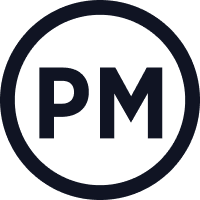
ProjectManager is the best project scheduling tool for 2025 because it allows teams to plan, schedule and manage projects all in one platform. It stands out with its flexible views, automated workflows and real-time collaboration tools that make scheduling simple and efficient. You can create detailed timelines, track progress and manage resources without switching between apps. It’s a complete solution for teams that need visibility and control from start to finish.
Schedule With Gantt Charts
ProjectManager’s online Gantt charts let users plan projects visually with task dependencies, milestones and progress tracking. Teams can drag and drop tasks to adjust schedules, assign owners and link all four types of task dependencies to avoid cost overruns. Users can filter quickly for the critical path and identify those tasks with zero slack. Set a baseline and the platform updates in real time so everyone always sees the latest timeline and track progress, spending and more.
With AI Project Insights, users can get a summary and recommendations on next steps instantly. Whether managing a construction project or software release, these Gantt charts keep schedules accurate and easy to understand.
Track Your Resources
Resource management is built directly into ProjectManager. The workload chart and team page make it simple to see who’s busy and who’s available so managers can balance assignments and prevent burnout. Managers can even update tasks without leaving the team page. Real-time visibility into resource allocation helps teams deliver work efficiently and stay within budget. It’s a reliable way to ensure the right people are working on the right tasks at the right time.
Streamline Payroll
ProjectManager also simplifies payroll with its powerful time tracking and secure timesheet features. Teams can log hours directly in the platform, even in the field, with mobile apps for Android and iOS, making labor cost tracking effortless. Managers can approve timesheets and export data for payroll processing with a few clicks. This reduces errors, improves accuracy and keeps financial tracking in sync with project progress.
With all these features, including version control to revert to past schedules if needed, unlimited file storage and global search to find documents fast and easy, plus AI summaries and suggestions that provide insight and direction, real-time dashboards and customizable reporting tools, ProjectManager is the sure choice for anyone scheduling in construction, manufacturing, professional services, IT and more. Click here to start a 30-day free trial.
ProjectManager Pros & Key Features
- Powerful Gantt charts with task dependencies and milestones
- Real-time collaboration across teams and departments
- Workload charts for balancing team capacity
- Built-in timesheets for labor tracking and payroll integration
- AI-powered dashboards and reports for data-driven insights
- Customizable templates that accelerate project setup
ProjectManager Cons & Limitations
- May require onboarding for users new to project scheduling tools
- Some advanced reporting features are available only in higher-tier plans
ProjectManager Pricing
- Team: $14.00/user/month
- Business: $26.00/user/month
- Enterprise: contact sales for a custom quote
ProjectManager Reviews
- G2 review: 4.4/5
- Capterra review: 4.1/5
Highlighted User Reviews
- “ProjectManager works very well with both large and small-scale projects. Being able to use this with anything from a project involving only two members of staff, to hundreds, has been invaluable.” Peter W – from Capterra
- “We used to manage our projects, resources, and reporting in different systems. Enter ProjectManager. We have consolidated systems and work more efficiently.” Jeffrey M – from Capterra
- “Having the full scope of activities and who is responsible to do it, plus the time tracking is excellent.” Flavio M – from G2
- “It has an excellent accounting system capable of calculating the time that a person has used to develop a task that was assigned to him, I like being able to collaborate with all my colleagues in the Finance sector through ProjectManager.” Jesus C – from G2
- “The UI of the application is user-friendly, and it helps to identify what we are looking for with minimal effort.” Pavan H – from G2
2. Microsoft Project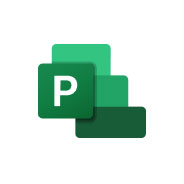
Microsoft Project has long been a staple in project scheduling tools, offering Gantt charts, task dependency management and resource allocation features. Many teams relied on it for detailed project planning and progress tracking. Its integration with Microsoft 365 allowed seamless collaboration across familiar apps, making it suitable for large-scale projects that require structured scheduling and reporting.

However, Microsoft Project is being retired and it has notable limitations. The software is desktop-centric, which makes real-time collaboration and remote updates cumbersome. Its interface can be complex for new users and automation features are limited compared to modern cloud-based alternatives. Teams often need additional tools to manage communication, dashboards and reporting, which adds complexity and cost.
Verdict: Best Project Scheduling Tool for Microsoft Users
Microsoft Project Pros & Key Features
- Comprehensive Gantt charts with task dependencies
- Resource allocation and management tools
- Integration with Microsoft 365 apps
- Advanced project planning and scheduling capabilities
- Customizable reporting features
Microsoft Project Cons & Limitations
- Being retired, no long-term support or updates
- Complex desktop interface with steep learning curve
- Limited real-time collaboration features
- Requires additional tools for dashboards and automated reporting
Microsoft Project Pricing
- Project Standard 2024: $679.99, one-time license purchase
- Project Professional 2024: $1,129.99, one-time license purchase
Microsoft Project Reviews
- G2 review: 4/5
- Capterra review: 4.4/5
Highlighted User Reviews
- “It’s a powerful tool for managing complex projects, offering detailed features like task scheduling, resource allocation, and progress tracking.” Mazhar A – from Capterra
- “The quality of MS Project output is often sufficient for the requirement of most projects.” Paul B – from Capterra
- “I love the automatically generated gantt charts and the timeline feature.” Eric B – from G2
- “It is easy to set up a project plan using templates provided in MS Project.” Alex N – from G2
3. Smartsheet
Smartsheet is a cloud-based project scheduling tool praised for its flexibility and ease of use. Teams benefit from spreadsheet-style interfaces combined with Gantt charts, dashboards and automated workflows. Its collaboration features allow multiple users to update tasks in real time, making it ideal for distributed teams and complex projects. Integration with other software and reporting tools also enhances project visibility and decision-making.

Despite its strengths, Smartsheet has drawbacks. The interface can feel overwhelming for new users due to its extensive features, and the cost can be high for smaller teams. Some advanced project scheduling features require manual setup and resource management isn’t as detailed as in dedicated project management software. Users may need additional apps to fully track labor costs and progress metrics.
Verdict: Best Project Scheduling Tool for Spreadsheet Users
Smartsheet Pros & Key Features
- Cloud-based with real-time collaboration
- Spreadsheet-style interface with Gantt charts
- Automated workflows and notifications
- Customizable dashboards and reporting tools
- Integrates with multiple third-party apps
Smartsheet Cons & Limitations
- Steep learning curve for new users
- High cost for smaller teams
- Advanced resource management requires manual setup
- Additional apps needed for comprehensive labor tracking
Smartsheet Pricing
- Pro: $9.00/user/month, billed annually
- Business: $19.00/user/month, billed annually
- Enterprise: contact sales for a custom quote
- Advanced Work Management: contact sales for a custom quote
Smartsheet Reviews
- G2 review: 4.4/5
- Capterra review: 4.5/5
Highlighted User Reviews
- “Smartsheet is a great platform for data visualization and project management.” Pathan I – from Capterra
- “Good for tracking projects but takes some time to learn all of the features.” Marissa P – from Capterra
- “Automation can save hours of time by automatically sending emails and reminders to ensure we meet our deadlines.” Amy S – from G2
- “Easily allows a shareable document that concurrent users can view and make live changes to.” Steven K – from G2
4. Asana
Asana is a cloud-based project scheduling tool that helps teams plan, organize and track work visually. With its task lists, timelines, kanban boards and calendar views, Asana enables project managers to coordinate multiple projects simultaneously. Its collaboration features, such as comments, notifications and file attachments, ensure teams stay aligned and deadlines are met.
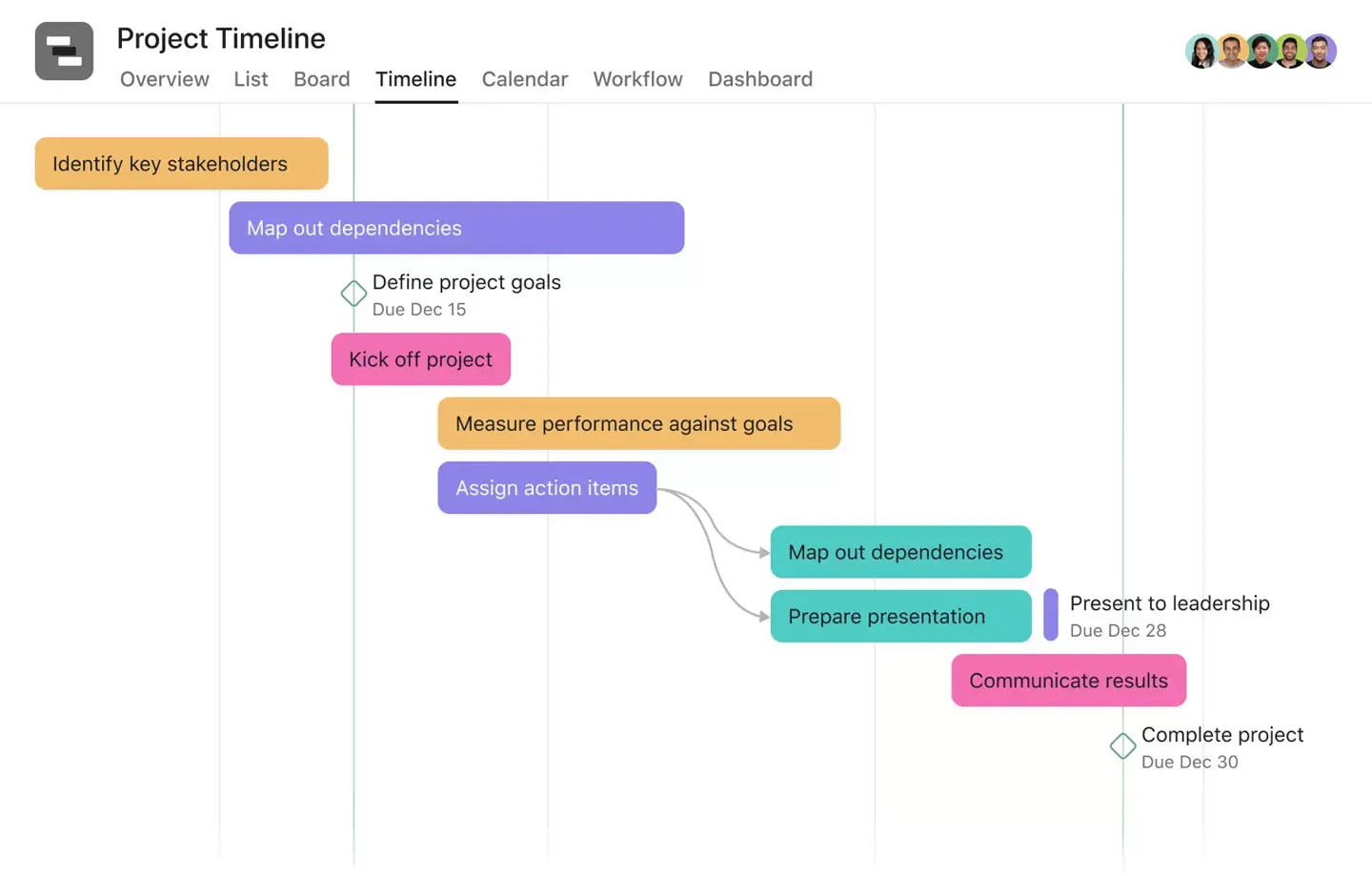
However, Asana has limitations that may impact larger or highly complex projects. It lacks detailed resource management and advanced workload tracking, making it less ideal for teams needing to monitor labor costs or resource allocation closely. Some features, like reporting and automation, require premium plans, and the interface can be confusing for new users when managing multiple projects.
Verdict: Best Project Scheduling Tool for Small Projects
Asana Pros & Key Features
- Cloud-based with real-time collaboration
- Task lists, kanban boards, timelines and calendar views
- Customizable project workflows and templates
- Notifications, comments and file attachments
- Integrates with popular productivity and communication apps
Asana Cons & Limitations
- Limited resource management and workload tracking
- Advanced features require premium plans
- Interface can be confusing for large projects
- Not ideal for tracking labor costs or complex dependencies
Asana Pricing
- Premium plan: $10.99/user/month, billed annually
- Business plan: $24.99/user/month, billed annually
Asana Reviews
- G2 review: 4.4/5
- Capterra review: 4.5/5
Highlighted User Reviews
- “I can create tasks, set their dates, routines, collaborate with my teammates, see their tasks, private my tasks, and so much more.” Shivam K – from G2
- “The dashboard view is the main benefit; it helped me organize the work into stages and gave me a clear picture of how far along the team was.” Carrie C – from G2
- “I am mesmerised with Asana because it has done wonders to me. My clients appreciate my work and it all because of Asana.” Fujimory C. – from Capterra
- “Asana is so much easy to use and it is well equipped with fantastic tools that help me get tasks done.” Simeon O. – from Capterra
5. Monday.com
Monday.com is a visual project scheduling tool known for its customizable boards, colorful interface and ease of use. It supports multiple project scheduling views, including Gantt charts, calendars and kanban boards, allowing teams to manage workflows efficiently. Automation features streamline repetitive tasks and integrations with tools like Slack, Google Drive and Microsoft Teams enhance collaboration across departments.

Despite its flexibility, Monday.com can become expensive as teams scale and need access to advanced features. Its resource management and time tracking capabilities are basic compared to more robust project management software. Some users also report difficulty maintaining consistency across large projects, as customizations can create confusion without standardized templates or structures.
Verdict: Best Project Scheduling Tool for Everyday Task Management
Monday.com Pros & Key Features
- Highly visual and easy-to-use interface
- Multiple project scheduling views, including Gantt, kanban and calendar
- Strong automation tools for repetitive workflows
- Wide range of integrations with third-party tools
- Customizable dashboards for tracking progress
Monday.com Cons & Limitations
- Becomes costly for larger teams or premium features
- Limited resource management and time tracking
- Customization can cause inconsistency across projects
- Reporting tools are less advanced than competitors ‘
Monday.com Pricing
- Pro: $7 per user/month (maximum of 10 users)
- Business: $25 per user/month (minimum of 3 users)
Monday.com Reviews
- G2 review: 4.4/5
- Capterra review: 4.5/5
Highlighted User Reviews
- “I truly recommend using Monday.com to small to medium scale enterprises because of its ease of use.” Vikas G – from G2
- “I really like the Monday.com work management interface.” Luiz Fernando J – from G2
- “Monday.com did prove to be useful however there is a major learning curve though. I feel it could be redone to be more user friendly.” Kayla S. – from Capterra
- “Overall Monday.com is very simple to use and helps to manage business activities while tracking important sales targets and revenue.” Ceilidh L. – from Capterra
6. Trello
Trello is a simple and intuitive project scheduling tool that uses a kanban-style board to visualize tasks and workflows. Its drag-and-drop interface makes it easy to assign work, track progress and manage project timelines. Trello is ideal for small teams or individuals who want a lightweight way to organize tasks without a complex setup. Integrations with apps like Slack, Google Drive and Jira further enhance its functionality.
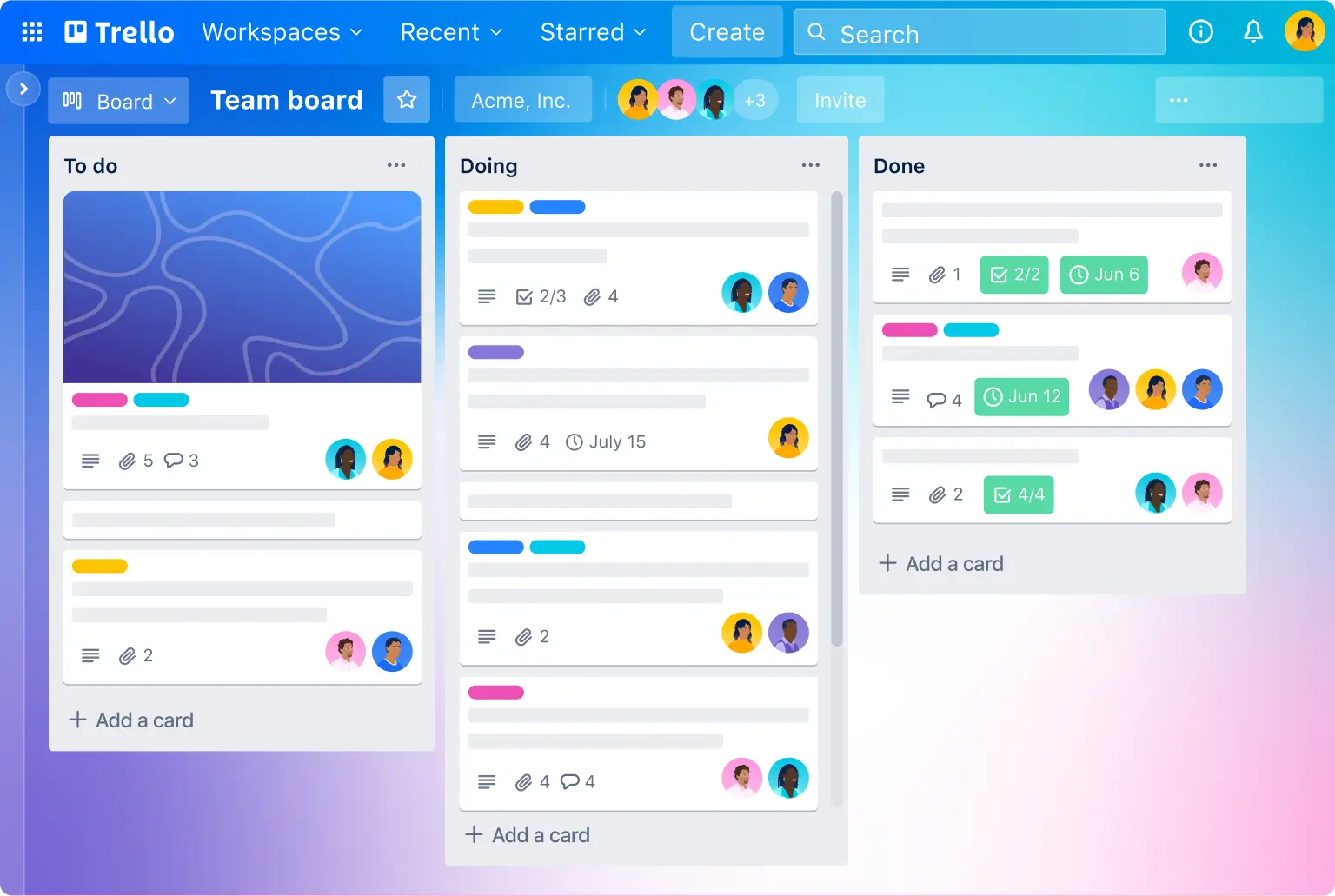
However, Trello’s simplicity can become a drawback for larger or more complex projects. It lacks native Gantt charts, resource management and advanced scheduling tools that are essential for detailed project planning. Teams often need paid upgrades or third-party integrations to access features like time tracking and reporting, which can make Trello less efficient for enterprise use.
Verdict: Best Project Scheduling Tool for Kanban Boards
Trello Pros & Key Features
- Simple and intuitive kanban board interface
- Easy drag-and-drop task management
- Seamless integrations with popular productivity apps
- Ideal for small teams or personal task tracking
- Highly customizable with Power-Ups and automation
Trello Cons & Limitations
- Lacks native Gantt charts and timeline views
- No built-in resource management tools
- Limited reporting and analytics capabilities
- Relies heavily on paid add-ons for advanced features
Trello Pricing
- Standard: $5/user/month, billed annually
- Premium: $10/user/month, billed annually
- Enterprise: $17.50/user/month, billed annually
Trello Reviews
- G2 review: 4.4/5
- Capterra review: 4.5/5
Highlighted User Reviews
- “It allows me to add collaborators, sort my boards, add due dates, notes for each item and assign labels (plus more). All in all, it’s a very useful tool for organization and communication on collaborative tasks with your team.” – Sarah E, from G2
- “It’s simple and easy to use. The app does an excellent job of mimicking the real version, such as the scrum or kanban boards I use at work. It has enabled my team to connect from various locations and contribute without any issues.” – Ranmalee G. from G2
- “The fact that the price is worth it, makes it great. It is also so easy to use and manage. I love it.” – Zoe S. from Capterra
- “Very easy to use to find competitor intel, product features, and helps with my productivity. Use it all the time.” – Jacob W. from Capterra
7. ProjectLibre
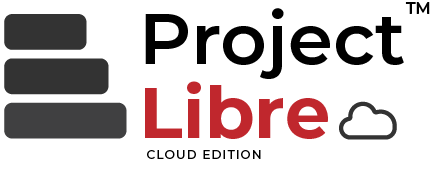
ProjectLibre is an open-source project scheduling tool often seen as a free alternative to Microsoft Project. It supports Gantt charts, task dependencies and critical path analysis, making it a solid option for users who need basic scheduling and planning features without paying for premium software. ProjectLibre is especially popular among educators, small teams and nonprofits looking for a low-cost project management solution.

While ProjectLibre offers strong fundamentals, it lacks the polish, integrations and collaboration features found in cloud-based tools. Its desktop-only design limits real-time updates and teamwork, and its interface can feel outdated compared to modern project scheduling software. Users managing multiple projects or distributed teams may find its reporting and resource management features insufficient.
Verdict: Best Open Source Project Scheduling Tool
ProjectLibre Pros & Key Features
- Free and open-source project scheduling software
- Supports Gantt charts, task dependencies and critical path analysis
- Compatible with Microsoft Project files
- Ideal for small teams, educators and nonprofits
- Provides offline project management capabilities
ProjectLibre Cons & Limitations
- Lacks cloud-based collaboration and real-time updates
- Outdated user interface and limited usability
- No integrations with modern business tools
- Limited resource and portfolio management features
ProjectLibre Pricing
- Free downloadable software
ProjectLibre Reviews
- G2 review: 4.2/5
- Capterra review: 4.4/5
- GetApp review: 4.4/5
Highlighted User Reviews
- “It’s open-source. It also provides Gantt charts, defining task dependencies, setting milestones and allocating resources.” Tisagh C – from G2
- “I was looking for a cheap or free alternative to MS Project to plan and follow my projects.” Nicolas B – from Capterra
- “This software is free! Also, it is very stable and has been around enough to have good help online and it is easy to import and export.” Max P – from GetApp
- “As I have been using this almost everyday, the demand for changing schedules dates frequently can be a drag. But this product, ProjectLibre has been a very useful tool in getting things done in the office.” Ysmael R.– from Capterra
Related: 9 Best Time Tracking Software for Consultants
What Are the Main Benefits of Using Project Scheduling Tools?
Project scheduling tools help teams plan, manage and deliver work efficiently. By visualizing timelines, assigning resources and tracking progress, these tools enhance communication and coordination, ensuring every task stays on schedule. They’re essential for reducing risks and keeping projects aligned with budgets and deadlines.
Reduces Project Delays and Cost Overruns
One of the most significant advantages of using project scheduling tools is their ability to prevent schedule slippage and budget inflation. By identifying task dependencies and potential bottlenecks, teams can plan resources strategically and avoid conflicts. This proactive approach reduces downtime, streamlines workflows and keeps project costs under control from start to finish.
Facilitates Project Monitoring and Control
Project scheduling tools give managers real-time visibility into project progress. Dashboards and automated reports help track key performance indicators, resource utilization and deadlines. This allows teams to detect issues early and make data-driven adjustments that keep projects on target. The result is improved accountability, transparency and overall project performance.
Allows Project Teams to Adjust Project Schedules
Project scheduling software enables teams to modify timelines dynamically when project conditions change. It supports schedule compression techniques such as fast tracking and crashing, helping reduce overall duration without compromising quality. Additionally, teams can make resource-based schedule adjustments by reallocating workloads, leveling resources or shifting task assignments. This flexibility ensures that deadlines remain achievable even when constraints arise. By providing real-time visibility into dependencies and resource availability, project scheduling tools empower managers to make informed adjustments quickly, maintaining both efficiency and project control.
Related Project Scheduling Content
Now that you know the best project scheduling tools, let’s take a deeper look at project scheduling. Below are links to more software reviews, techniques and much more.
- 15 Best Project Scheduling Templates for Excel
- Top 10 Project Scheduling Techniques (With Pros and Cons)
- How to make a CPM Schedule: CPM Scheduling Basics
- Resource Scheduling in Project Management
- What Is a Master Schedule in Project Management?
- Schedule Variance: What Is It & How Do I Calculate It?
- What Is Schedule Planning In Project Management?
ProjectManager is online project and portfolio management software that connects teams, whether they’re in the office or out in the field. They can share files, comment at the task level and stay updated with email and in-app notifications. Get started with ProjectManager today for free.